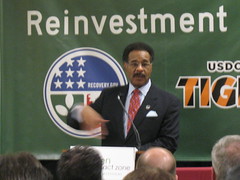 Image by MoBikeFed via Flickr
Image by MoBikeFed via FlickrA couple weeks ago, I had the privilege to attend the national "Good Jobs, Green Jobs" conference in Washington, DC. One of the many outstanding workshops I attended during the conference was entitled "Infrastructure and Job Creation: A Priority for Urban America." The workshop featured a panel of two progressive champions, Rep. Keith Ellison of Minneapolis and Rep. Emanuel Cleaver of Kansas City. The congressmen were extremely insightful on the problems currently facing urban America, and both felt that the green jobs and renewed federal investment were the best solutions to revitalizing our cities.
During the panel discussion, I was particularly intrigued by Representative Cleaver's idea for a "Green Impact Zone" in the heart of Kansas City. The congressman plans to focus all of the federal stimulus sill funding he receives for his 5th District of Missouri within a concentrated, 150 block area in the urban core. According to Representative Cleaver, "The Green Impact Zone initiative is an effort to concentrate resources — with funding, coordination, and public and private partnerships — in one specific area to demonstrate that a targeted effort can literally transform a community."
The Green Impact Zone will use community-based approached to revitalize the designated area in Kansas City, including:
- Innovative strategies to address weatherization of homes within the zone.
- A coordinated community policing and community services center
- A multi-pronged housing improvement program for current homeowners and residents.
- An employment and training program coordinated both with zone activities and business interests outside of the zone.
- Development and implementation of a sustainability strategy for the zone, including energy efficiency and renewable energy sources and green solutions to water and waste water issues
- Installation of a smart grid by Kansas City Power and Light, and integration with other energy efficiency and renewable energy initiatives
- Development and implementation of an economic development strategy.
- An integrated strategy to address abandoned and foreclosed properties and vacant lots.
I was reminded of Representative Cleaver's plan after reading Jonathan Hiskes recent commentary on the revival of enthusiasm for urban living from America's youth. As Hiske writes, "A recent Brookings Study found young whites moving into urban centers in record numbers. Harvard Business Review recently advised businesses to consider moving into cities if they want to attract bright young workers of any race."
However, many American policy makers do not share this enthusiasm for a revitalization of American cities. When current members of Congress came of age, American cities were floundering. New York Time's columnist David Brooks recent piece describes how the crime wave of the '60s and '70s scared a generation of Americans (or at least, of white, mobile Americans) away from urban living. Brooks feels that the this experience of growing up with urban crime formed a "psychological understanding of cities as hotbeds of crime and decay [that] remains among Baby Boomers."
Hiske wonders how can we make Congress see the potential gains of reinvesting in our cities. Clearly some members, such as Representatives Cleaver and Ellison, already see the value of investment and are actively pursuing policies that will strengthen urban America. But we will need more support than just two members of Congress to achieve the goal of creating truly sustainable cities.
No comments:
Post a Comment